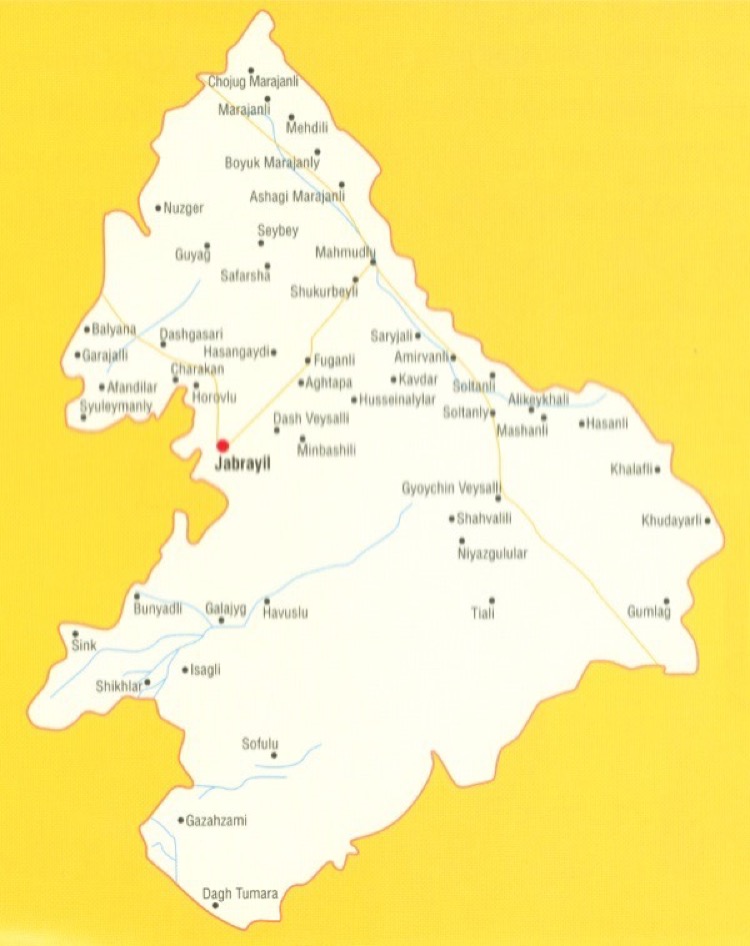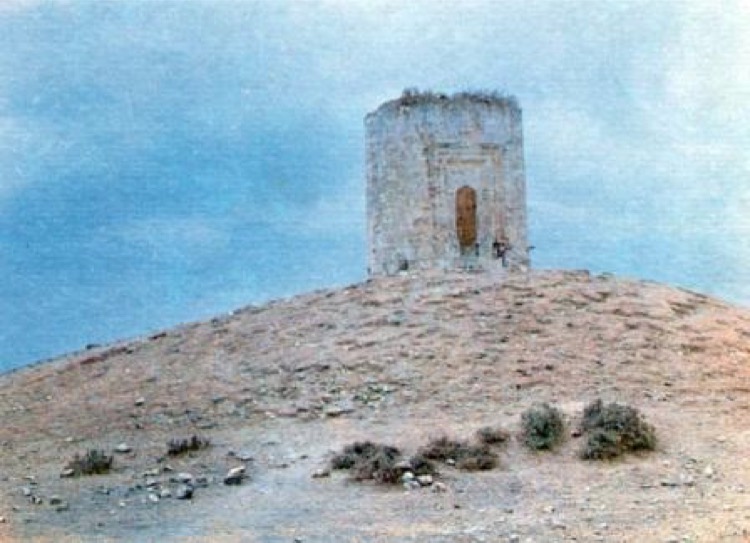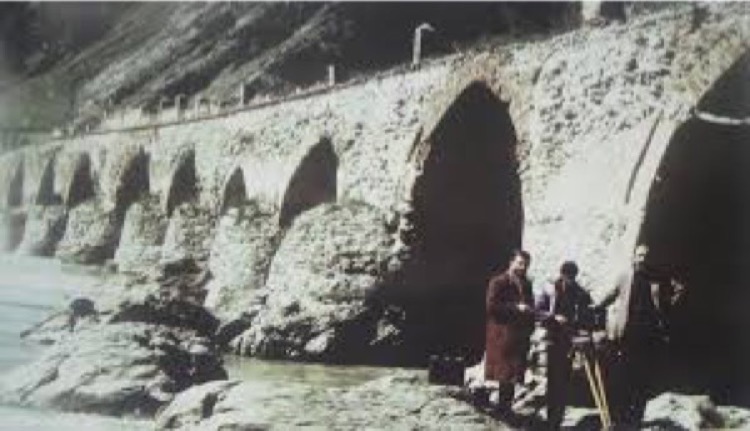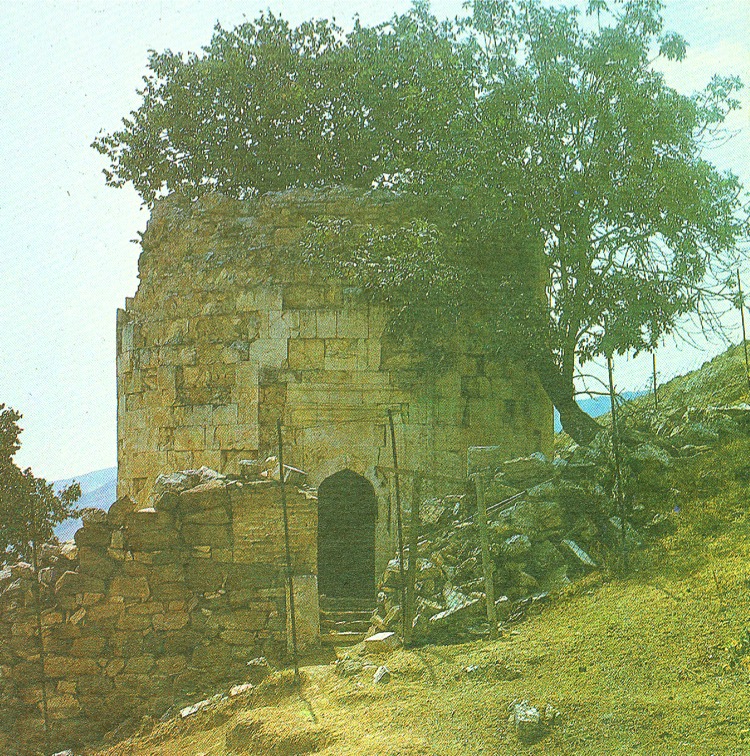Jabrayil district - is the administrative district of the Republic of Azerbaijan. In the south and the south-eastern part, it neighbors with the Islamic Republic of Iran. Its area is 1050 km2; the population is 81,700 (01.01.2020). The central town is the city of Jabrayil. The region's territory was occupied by the Armenian army on August 23, 1993. During September 27-November 9, 2020 Jabrayil city and 90 villages of the district were liberated from occupation.
The district covers the followings: Jabrayil city, Gumlag, Khalafli; Khudaferin and Mahmudlu settlements and villages of Yarahmadli; Khudaverdili; Gurbantepe; Shahveledli; Khubyarly; Imambaghi; Horovlu; Chapand; Safarsha; Chereken; Papy; Efendiler; Balyand; Garajally; Doshulu; Suleymanly; Dashkesen; Ghyshlag; Guychag; Sheybey; Nuzgar; Shahvelli; Niyazgullar; Tinli; Govshudlu; Haji Isagly; Goshabulag; Shukurbayli; Shykhalyagaly; Fuganly; Dejel; Amirvarly; Sarychally; Mazra; Yukhary Mazra; Soltanly; Kechal Mammadli; Yanarkhach; Alykeykhaly; Mashanly; Hasanly; Mehdili; Chakhyrly; Minbashyly; Sadi; Agtepe; Kavdar; Mirek; Huseynalylar; Hajyly; Tulus; Dag Tumas; Garagach; Sofulu; Chelebiler; Dag Mashanly; Gazanzemi; Soyudlu; Ashaghy Maralyan; Yukhary Maralyan; Karkhulu; Jafarabad; Isagly; Galachyg; Hovuslu; Sirik; Ashaghy Sirik; Shykhlar; Mollahasanli; Asgarkhanly; Khalafli; Garer; Kudlar; Nusus; Tatar; Gumlag; Mastalybayli; Goyarchin; Veysalli; Boyuk Marjanly; Yukhary Marjanly, Khanagabulag; Chullu; Derzili; Dash Veysalli; Yukhary Nusus; Ashyq Melikli; Niftalylar; Gushchular; Hasangaydy; Mahmudlu; Chochug Marjanly.
The district's landscape is mainly plain with slopes (Injachol; Gayan cholu). It is low mountainous in the north (such as south-eastern lowlands of the Karabakh Chain).
Before the occupation, viticulture, livestock sector and cereals cultivation played a main role in the economy of the district. The following educational and social institutions were active before the invasion: 72 secondary schools; 40 clubs; 78 libraries; 8 hospitals; 11 medical treatment and 52 maternity institutions.
Prior to the occupation, many historical and archaeological monuments as well as masterpieces of architecture (such as ancient living mansions; burial mounds; mosques; hammams; round and octahedral turbehs, the Khudaferin bridge etc) existed in the territory of district.
Bashikesik Dome (Tomb)
The dome built in the 13th-14th centuries located in Daghtumas village of Jabrayil district was named “Bashikesik dome” (Headless dome) due to its open ceiling. The monument is 12 meters in height and 5 meters in diameter. The dome was reconstructed before the invasion. Some parts of the dome walls were destroyed by the Armenian Armed Forces.
On October 23, 2020 the village was liberated from occupation.
History and Ethnography Museum of Jabrayil District
History and Ethnography Museum of Jabrayil district was established on December 8, 1980. Nearly 19 thousand exhibits related to Jabrayil district were collected in the museum.
During the attacks of the Armenian Armed Forces to Jabrayil district in 1993, nearly 16 thousand museum pieces were salvaged. A number of immovable museum pieces, in total, over 2 thousand exhibits were destroyed by the Armenian invaders.
On October 4, 2020 Jabrayil city was liberated from occupation.
Jamil Ahmedov’s Memorial Museum
The memorial museum of the Hero of the Soviet Union Jamil Ahmedov born in Jabrayil village of the Jabrayil region was established in 1985, as a branch of the History and Ethnography Museum of Jabrayil region.
The memorial museum was constructed in the courtyard of the secondary school named after Jamil Ahmedov by the resolution of the USSR Council of Ministers. The museum covering a total area of 100 square meters was consisted of three rooms. Jamil Ahmedov’s bust was put up by the well-known sculptor Omar Eldarov.
At the beginning the museum contained about 500 exhibits, and then the number of exhibits increased to 800.
A very small number of museum pieces were handed over to the museum center in Baku a while before the occupation of the Jabrayil district by the Armed Forces of Armenia in 1993. At the present time those exhibits are kept in the Independence Museum of Azerbaijan.
Jamil Ahmedov is the People’s Writer Sabir Ahmedli’s brother.
On October 4, 2020 Jabrayil city was liberated from occupation.
Khudafarin bridges
Though many bridges were built across Araz river for centuries, only two of them in the Jabrayil region have survived. 750 meters away from each other, they are located in one of the Araz’s best fords, the Khudafarin Gorge. In fact, there are large rocky massifs in the expanding bed. Those rocks made a reliable fundament for the bridge beams.
The 15-arched long bridge built of bricks and river stones are pointed. The total length is nearly 200 meters, the width is 4.5 meters, the maximum height over the river surface is 12 meters, the longest beam pass is 8.70 meters, and the shortest beam pass is 5.80 meters. All the beams are of bricks, while the main part of the bridge was constructed from river stones.
The other, 11-arched Khudafarin Bridge, located upriver, was entirely stone-built and covered with good-hewn stone plates.
Researches suppose it was rebuilt in the 13th century on ruins of an antique one. The total length is 130 meters, the width is 6 meters, and the maximum height over the river surface is 12 meters. As only three, middle spans of the bridge have survived, it is popularly called “Sinig Korpu” (Broken Bridge).
Khudafarin Bridges are universally valuable sites due to regarding the world-important historical events, matching the beautiful landscape, high level of engineering performance, etc.
Parts of transcontinental roads including the Great Silk Road, the bridges were useful not only for domestic and international relations, but also for those between continents.
After the occupation of Jabrayil region by the Armenian Armed Forces in 1993, the Khudafarin Bridges remained in captivity as well.
On October 18-19, 2020 the Khudafarin Bridges were liberated from occupation.
Mosque-madrasa in Chelebiler village
The mosque-madrasa attributed to the 16th century and located in Chelebiler village of Jabrayil district was built by Mahammad Ibn Haji Garaman in Hegira 1088, AD 1678. Religious and secular sciences were taught at the madrasa by the scientists and scholars. Famous Azerbaijani poet of the 18th century Molla Veli Vidadi also taught there. The pupils had their classes in special rooms – cells in the mosque. The mosque - madrasa complex had been fully restored before the occupation of the Jabrayil region by the Armenian Armed Forces in 1993.
At the present time the mosque-madrasa is completely destroyed.
On October 26, 2020 the village was liberated from occupation.
Shikhlar Tomb (Round tomb)
Shikhlar tomb built in the 14th century in the vicinity of Shikhlar village of Jabrayil district is 8 meters high, 6 meters in diameter. The upper part of the dome of Shikhlar tomb was destroyed during the invasion carried out by the Armenian Armed Forces.
On October 22, 2020 the village was liberated from occupation.
Tombs in Khubyarly Village
A remarkable piece of the medieval architecture - “Dairevi” (Round ) tomb built in the 15th century, located in Khubyarly village in the north of Jabrayil city and octagonal tomb built in the 16th century were fully restored by the special maintenance crew before the occupation of the Jabrayil region. According to the information received those monuments were also razed to the ground by the Armenian invaders.
On October 30, 2020 the village was liberated from occupation.
Immovable historical and cultural monuments of state importance
ARCHAEOLOGICAL MONUMENTS
| Name of the monument | Construction date |
Location |
Aghoghlan necropolis |
The Early Middle Ages |
Jabrayil district |
Karkhulu barrows and settlement |
The Bronze Age |
Karkhulu village |
Changulu barrow |
The Bronze Age |
To the north-west from Mahmudlu village |
Gushtapa barrow |
The Bronze Age |
To the north-west from Mahmudlu village |
Imangazan hills |
The Bronze Age |
Shikhlar village |
Shikhlar cave |
The Stone Age |
Shikhlar village |
Shikhli barrows |
Late Bronze Age |
Shikhli village |
Imamgazantapa barrow |
The Bronze Age |
Shikhli village |
Galadag rock and settlement |
The Early Middle Ages |
Galachig village |
Maschidtapa barrow |
The Bronze Age |
Galachig village |
Wintering barrows and settlement |
The Bronze Age |
Gishlag village |
Hovuzlu barrows |
Late Bronze and Early Iron Age |
Hovuzlu village |
Chinlitapa living place |
Early Iron Age |
Horovlu village |
Toraghaytapa living place |
Early Bronze Age |
Shukurbayli village |
Divlar palace |
The Stone Age |
Chalabilar village |
Immovable historical and cultural monuments of local importance
ARCHITECTURAL MONUMENTS
Name of the monument |
Construction date |
Location |
Bath of Sultan Allahverdi |
19th c. |
Jabrayil city |
Round mausoleum |
17th c. |
Khubyarli village |
Eight-pointed mausoleum |
17th c. |
Khubyarli village |
Round mausoleum |
14th c. |
Shikhlar village |
Tower of fortress |
|
Sirik village |
Maiden tower |
12th c. |
Diridagh mountain |
Mausoleum |
13th-14th cc. |
Daghtumas village |
Mosque |
|
Chalabilar village |
Mosque |
19th c. |
Papi village |
Mosque |
|
Dashkasan village |
Mosque |
19th c. |
Mazra village |
Mosque |
19th c. |
Suleymanli village |
ARCHAEOLOGICAL MONUMENTS
Name of the monument |
Construction date |
Location |
Old cemetery |
Middle Ages |
In the north-east of Jabrayil city |
Old cemetery |
17th-18th cc. |
Karkhulu village |
Old cemetery |
Middle Ages |
Sirik village |
Old cemetery |
Middle Ages |
Diridagh mountain |
Cave |
Middle Ages |
Dagh Tumas village |
Old cemetery |
Middle Ages |
Shikhlar village |
Ruins of Shaherjik village |
Middle Ages |
Shikhlar village |
Duluzkhana settlement |
Middle Ages |
Shikhlar village |
Hasanli settlement |
Middle Ages |
Hasanli plain |
Gala settlement |
Middle Ages |
Sirik village |
GARDEN-PARKS, MONUMENTAL AND MEMORIAL MONUMENTS
Name of the monument |
Construction date |
Location |
House-museum and monument of J. Ahmadov |
1985 |
Jabrayil city, Istiglaliyyat St. |
Memorial monument to our citizens, who died during World War II |
1975 |
Jabrayil city, near “Gartal” pavilion |
SAMPLE OF DECORATIVE-APPLIED ARTS (monuments of people art of stone-monuments)
Name of the monument |
Construction date |
Location |
Stone ram figures and plot |
Middle Ages |
In front of historical-regional museum |





